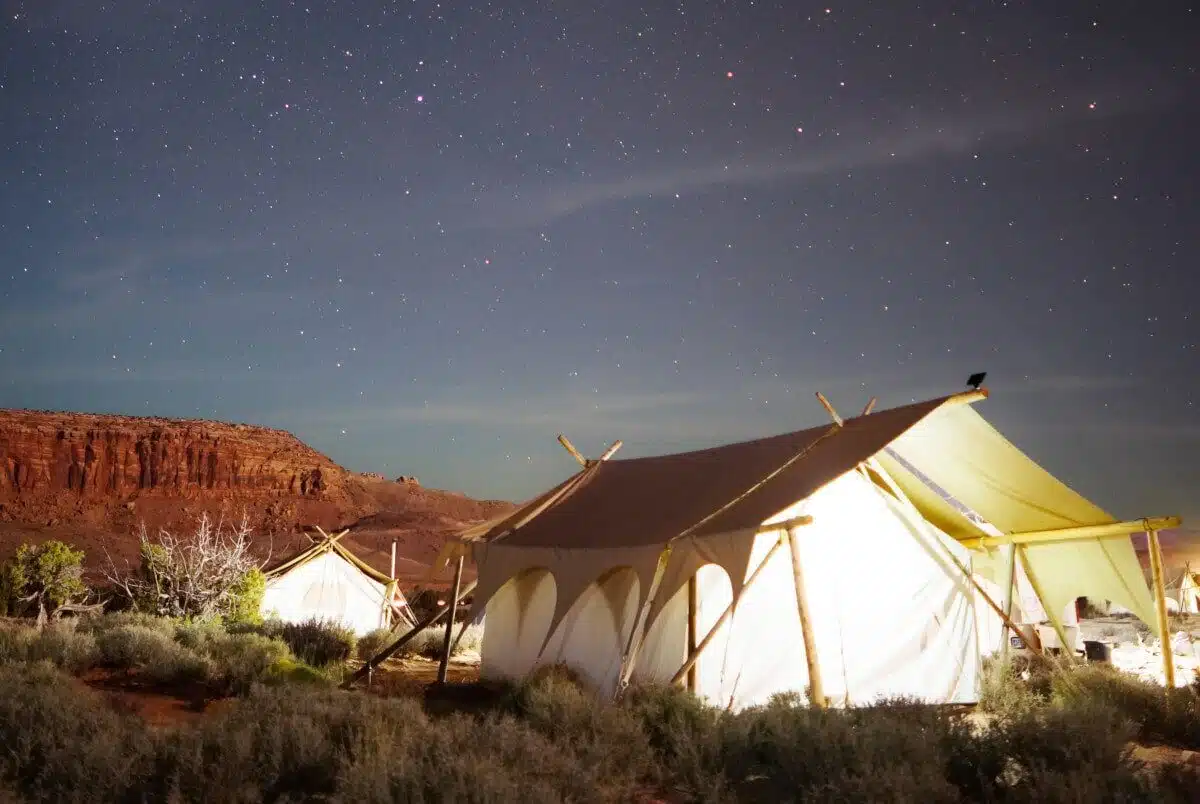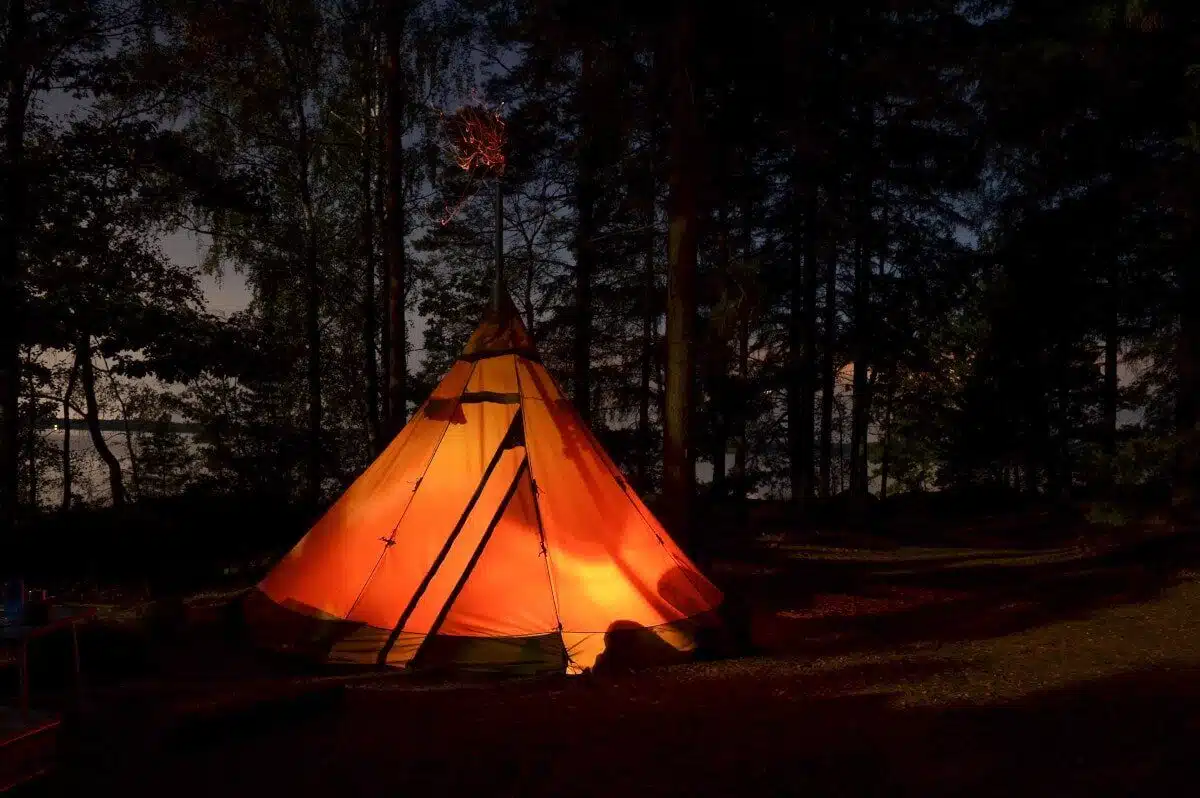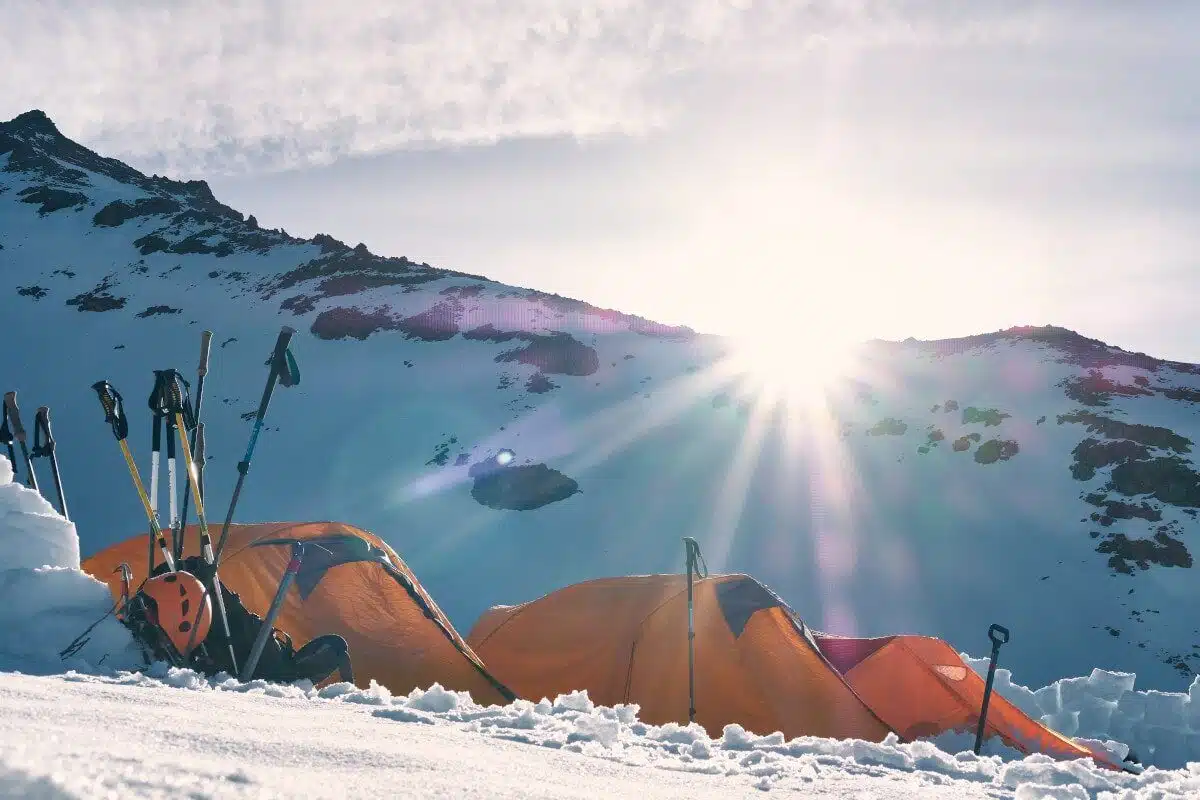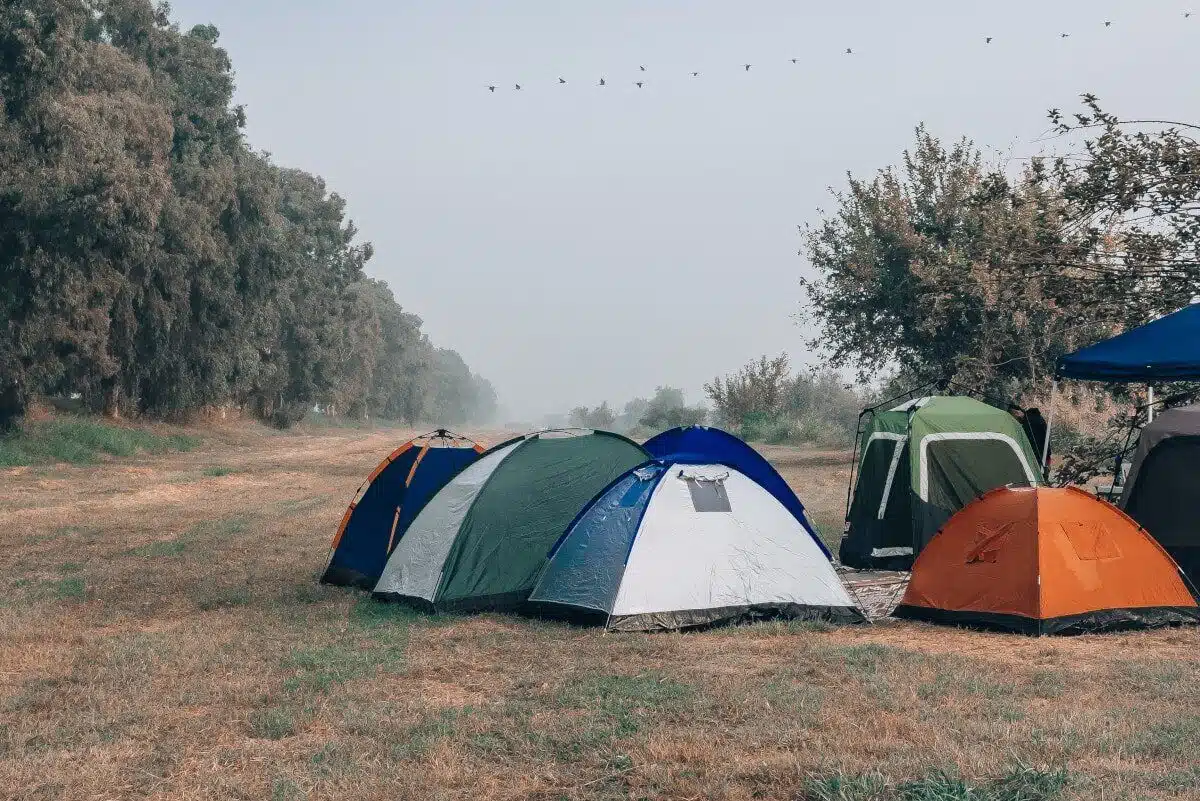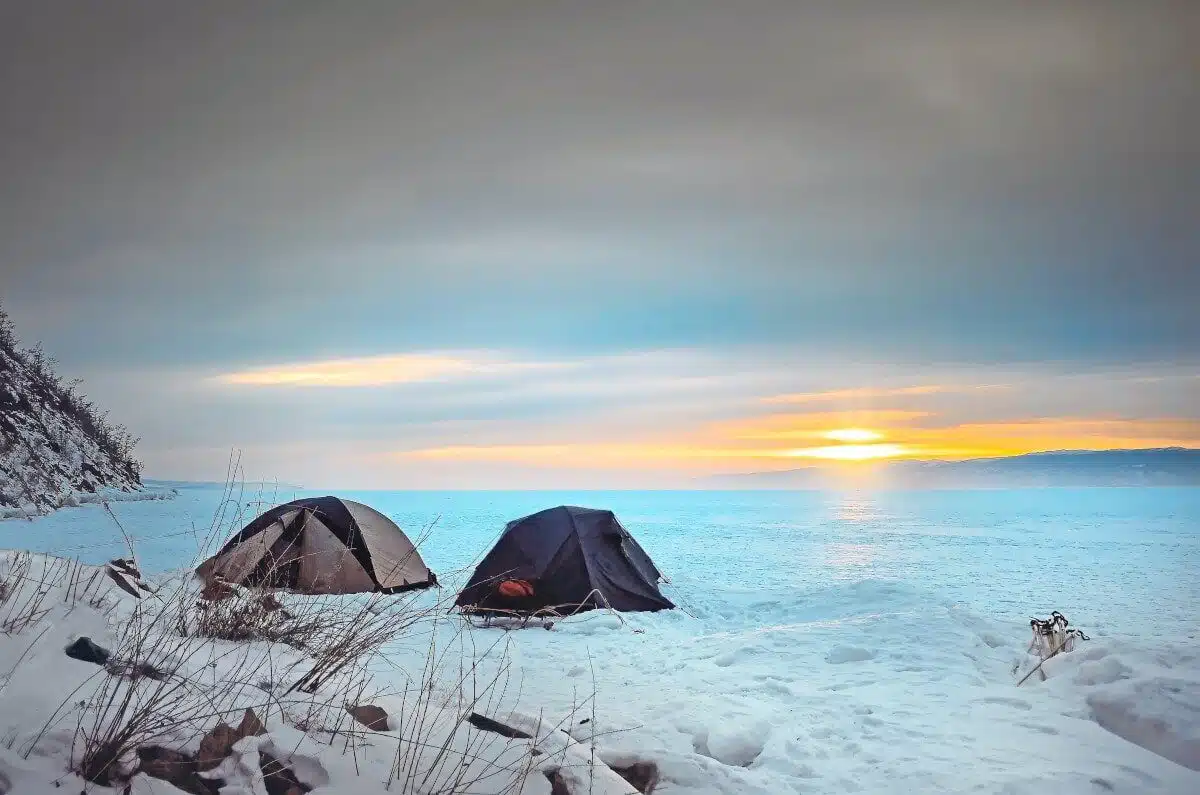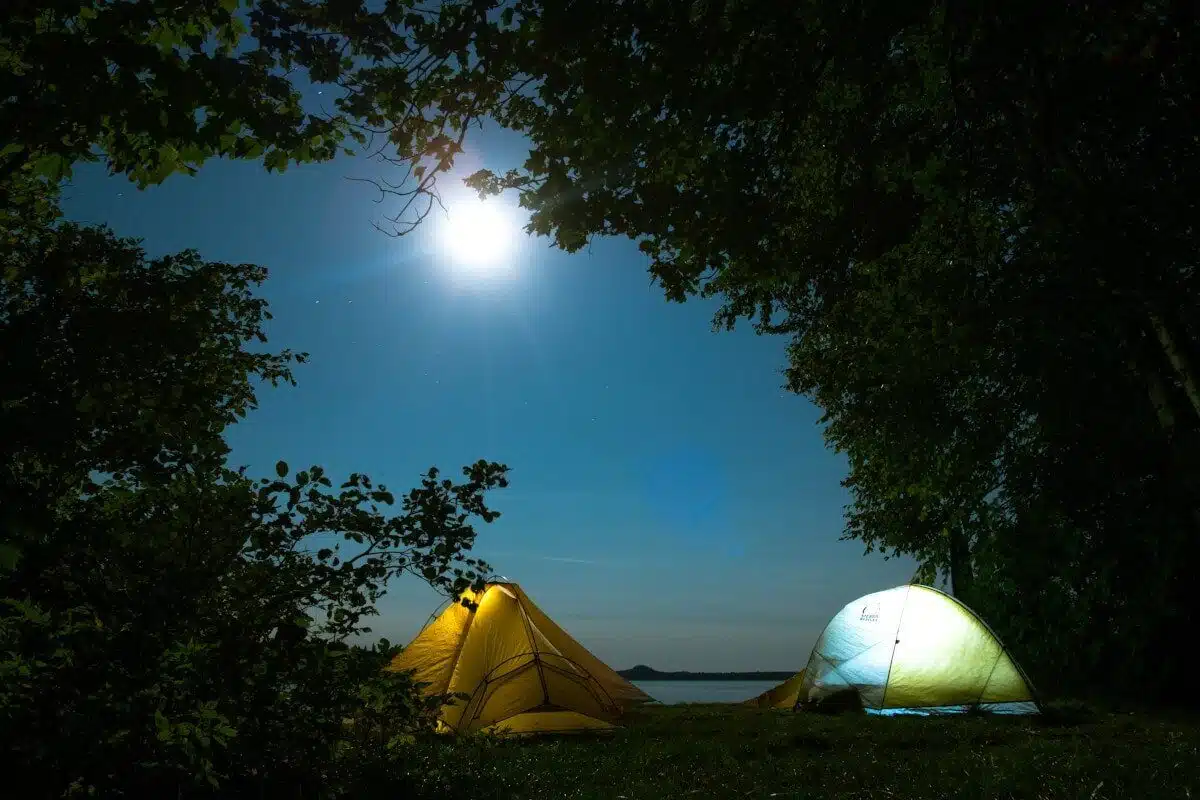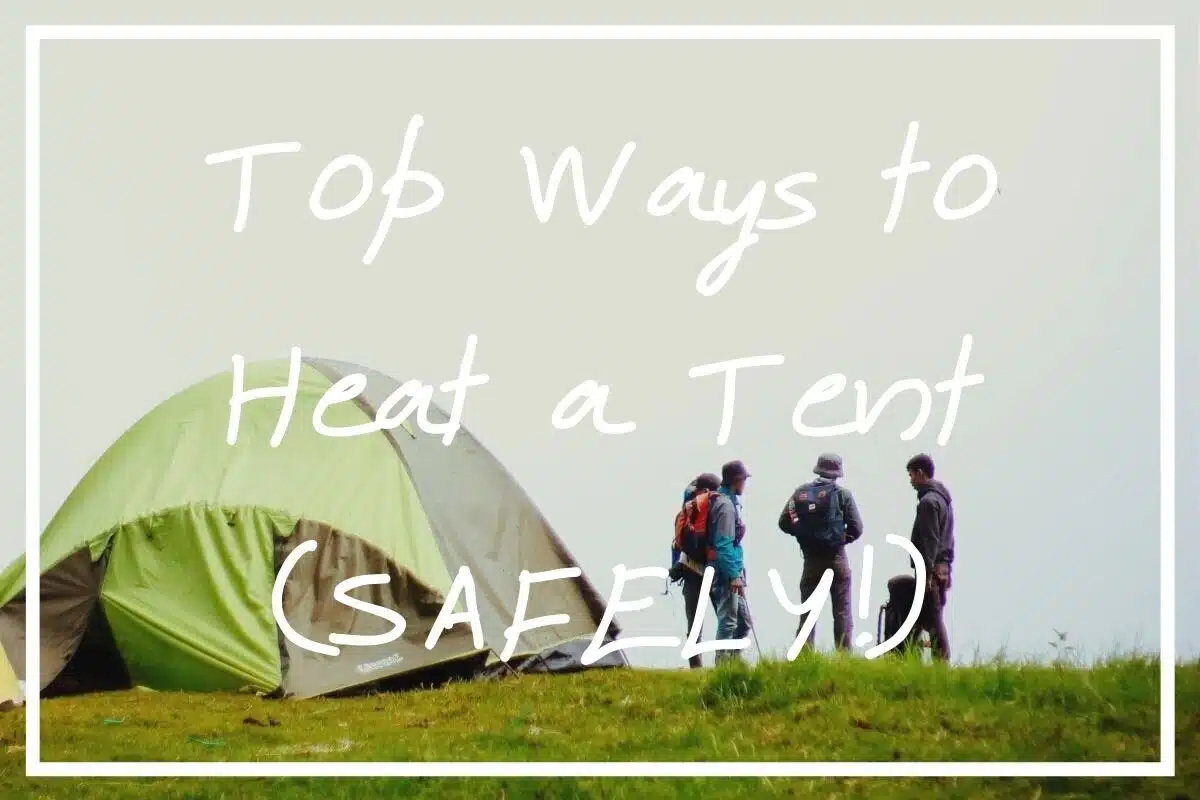
Are you wondering how to heat a tent on a cold night? I hope the suggestions in this post help!
When the temperatures dip and the nights get cooler, you might think camping season’s coming to an end.
However, if you’ve ever gazed up at the phenomenal winter constellations, you’ll know that this is an incredible time to head outdoors!
You don’t have to pack away your tent and stay home just because it’s a little chilly out. All you need are a few go-to ways to heat a tent safely!
With some camping heat tips up your sleeve, you can turn even the coldest night into an unforgettable memory.
With that in mind, I thought I’d share 10 simple suggestions on how to heat a tent in the great outdoors.
I’ll also go through a few basic safety tips so you can have fun, keep warm, and stay safe while you camp!
Knowing how to heat a tent can be the difference between a good and bad night’s sleep on your winter camping trips!
Key Considerations on How to Heat a Tent Safely & Effectively
Before I dive into how to keep your tent nice and toasty, there are a couple of valuable points to make first. Here are two suggestions that should help you heat your tent without putting yourself in danger in the process.
1. Pick the Perfect Campsite
First thing’s first: not all campsites are made equal when it comes to staying warm!
To have the best chance of heating a tent and stopping that heat escaping straight-away, it’s important to set yourself up in a place that’s conducive to those goals.
No matter where you trek, there are certain outdoor areas that are naturally warmer than others.
For instance, while the views from the top of a cliff might be incredible, the higher altitudes and exposed natures of these spaces also equal higher winds. Unless you’re lucky enough to get a still night, the wind chill could make it difficult to heat your tent properly.
For better results, try sticking to lower elevations- preferably near trees. The trunks and branches will act as natural windbreakers, shielding you and your tent from too much direct impact.
2. Be Wary of Hot Tents
Now, there are plenty of possible ways to fill your tent with heat (10 of which I’ll discuss in this blog post!). But if you’re an avid camper and love going on extended overnights trips in the colder months, it may be worth investing in a “hot tent” instead.
I should note that I’ve never used one myself. In short, though, these tents are specially designed to hold a wood-burning stove inside. This awesome feature’s made possible through the inclusion of a built-in stove jack. Needless to say, having a heater in a tent is arguably the best way to stay warm when you’re camping!
However, it’s also super important to follow strict safety protocols.
Keep in mind that standard tents aren’t designed to contain any form of gas heaters or stoves. As a result, they don’t contain the necessary ventilation systems required to let deadly gases (AKA carbon monoxide, otherwise known as “the silent killer”) escape while your tent heats up.
Simply setting up a stove or heater inside your tent can lead to lethal carbon monoxide poisoning. Think you can sidestep this risk by rigging up a way for gas to escape while you generate heat? Alternative methods can cause trouble too!
Take conventional propane heaters, for instance.
Burning one pound of propane generates around 1.6 pounds of moisture. With nowhere else to go, that water can quickly infiltrate your tent and make everything humid, damp, and depressing.
The bottom line?
Only a specialty heat tent is designed to hold any form of internal heat source. These are usually equipped with a special fireproof coating, and are more breathable than others on the market. Unless it says “hot tent” on the label, assume that any sort of “manmade heater” is a big no-no, including candles.
Here we go, then: 10 ways to heat a tent safely on cold, wintery nights!
Related Posts You Might Like:
- What to Wear Hiking!
- How to Boil Water Camping
- The Best 12 Person Tents
- The Best Instant Tents for Camping
- The Best Tent Waterproofing Sprays
- The Best Tent Brands On the Market
- The Best Canopy Tents
- The Best Teepee Style Tents
- The Best Coleman Tents for Sale
10 Simple Ways to Heat a Tent
With those tips on how to heat a tent behind us, let’s move onto the main event. Here are 10 relatively simple ways to heat a tent in a safe and effective manner.
1. Insulate Your Tent
If you’re currently in the market for a new tent, you can buy one that’s already fully insulated. This feature alone can help it retain heat and keep you much warmer, even on those blustery nights!
Not ready to shell out the cash for a brand-new one?
There are a few ways you can insulate a tent on your own. The main thing to keep in mind is that you don’t want your tent to overheat though. It’s easy to get carried away while adding layers of insulation, but you’ll want to keep some level of breathability too!
Start by considering the ground below your tent. Try simply laying a tarp down before you set everything up! The earth’s naturally the coldest spot around you, so adding this extra layer can make a big difference.
If you want to, you can thicken the bottom layer a bit by adding leaves, moss, or grass under your tarp too. Be sure to smooth it out so you can sleep as comfortably as possible!
If you want to take an alternative route, you can also position a tarp on top of your tent. Because heat rises, this will help prevent any heat you generate from escaping too quickly.
Just make sure to leave plenty of ventilation inside, so you can keep the air flowing and allow unwanted gases to safely escape.
2. Use Makeshift Hot Water Bottles
One of the easiest and longest-lasting ways to heat a tent safely is to use hot water bottles!
Before you head out on your adventure, gather a few hard, plastic bottles. You can also use metal bottles. (FYI, ordinary water bottles from the grocery store won’t work, as they’ll easily melt when you pour the boiling water inside).
Also, remember to pack something to boil your water in. Then, when you arrive at your campsite, simply heat it over a fire until it reaches boiling point. Pour it into the bottles and you’re good to go.
Place the bottles strategically around your tent. They may not flood your tent with heat, but they should emit enough warmth to make it more bearable.
One important reminder:
Be careful not to place the bottles anywhere a young child could roll over onto them. If they’re too hot, wrap them carefully in a T-shirt until they cool down a little!
Camping heat is all-important in bitter, snowy conditions like these!
3. Use Specialty Tent Heaters
I’ve mentioned that conventional propane heaters are something of a no-go.
And the same applies to any form of heater that isn’t rated for indoor use, such as a camp stove. These types of heaters emit carbon monoxide, which can quickly build up inside your tent and pose a major safety risk.
However, there are a few different kinds of heaters that are designed specifically for indoor use. Follow the safety instructions and ensure there’s adequate ventilation at all times, and these can be viable options to help you stay warm.
For instance, you can find mini indoor heaters from companies such as Mr. Heater. There are also companies like UCO that make small-scale candle lanterns.
While neither option will deliver an immense amount of heat, they can be useful- especially when used alongside other methods of heating a tent on this list.
4. Use Hot Stones
Hot stones work similarly to hot water bottles. Plus, they’re easier to maneuver and don’t require you to bring too much extra gear! All you’ll need are one or two heavy-duty cookie sheets.
To use this approach, just gather a few medium-sized stones from around your campsite. Make sure they’re super dry, though, as wet ones (near a stream or creek, for example) can contain water. Heat these bad boys up and it can create so much pressure they’ll actually explode!
When you’ve chosen the best possible stones, place them around your campfire (not in it!) while you make a meal. Then just enjoy your evening. Make some s’mores and tell stories! Hang a hammock and relax under the stars.
When it’s time to turn in for the night, use a strong stick to roll the stones onto the cookie sheets.
Then, just take the sheets into your tent! Place them far away from anyone or anything they could damage, and you can stay warm for a few hours. If the rocks are super hot, try wrapping them in shirts or towels to prevent them from melting the canvas on your tent.
Top Tip:
Those cookie sheets aren’t essential. If you’re careful, you can wrap those hot stones up inside your shirts/towels and place them straight into the tent.
Done properly, pitching your tent over the top of your old campfire can soon fill your tent with heat.
5. Pitch On a Dead Campfire
It might sound strange, but sleeping on top of a dead/dying campfire is another potential way to heat a tent!
The key is to take the time to plan this technique out beforehand.
Start by digging a shallow trench (about four to six inches deep) at the site where you want to sleep. Make sure it matches the width of your tent as closely as possible. Then, make, burn and enjoy your fire!
When you’re finished, ensure the flames are totally dead. Next, spread the hot coals all around the trench and cover it with two to three inches of dirt. Finally, set up your tent on top!
If you go this route, avoid using a sleeping pad. These are designed to reflect heat back to its source, so all that energy will go toward heating the coals instead of keeping you warm.
It also goes without saying, but you really should double-check there aren’t any embers that could create a fire hazard.
6. Connect Sleeping Bags
Now, unfortunately, most sleeping bags won’t just zip together.
But you can find some that are designed to hold two people! Or, if you’re alone, you can use the extra room to hold more blankets.
If you do want to purchase two separate bags, look for ones with zippers on opposite sides. Usually, this means buying one left-handed model and a corresponding, right-handed one. This way, the zippers will be next to one another when you lay them side-by-side.
I like doing this when I’m in a tent with someone else. By sleeping in what’s effectively the same sleeping bag, you share body heat throughout the night.
It might not ‘heat the tent’ per se, but it definitely keeps you warmer!
In situations as cold as these, knowing how to heat a tent and stay warm is super important!
7. Use An Electric Blanket
Well-reviewed, reputable electric blankets are another option when you’re looking to generate camping heat inside your tent.
Most will operate between 77 degrees Fahrenheit (25 degrees Celsius) to 118 degrees Fahrenheit (48 degrees Celsius). Just make sure yours comes with an automatic shut-off function to prevent overheating.
The main drawback to this option is that you’ll need to be near a power source, so it might not be feasible for boondocking (although you can find battery-powered electric blankets nowadays). You’ll also need to make sure your cord’s long enough to use comfortably.
For best results, use the electric blanket on top of your sleeping bag, not inside of it though! Do it the other way around and you can generate so much heat it becomes a little dangerous.
8. Wear Cold Weather Clothing
This may be a post on how to heat a tent, but there are a few steps you can take to help yourself stay as warm as possible while camping.
One of those is to wear the right clothes.
Basically, when you’re entering your tent, layer up!
Opt for an absorbent, breathable material for your base layer, such as a long-sleeved cotton shirt or a sweat-wicking athleisure top. Your mid layer’s all about insulation, so that’s where you’ll pile on your sweater or hoodie! You can also snuggle into an insulated down jacket.
Then, there’s your outer layer (or your ‘shell’). This material will need to be weather-resistant and super durable, so think heavy-duty rain jackets and windbreaker pants.
Of course, once you’re nice and snuggly inside your tent, you may want to shed that last layer. Still, keep on the base and mid-layer until you warm up.
As the temperature inside the tent rises, you can remove the layers as you feel comfortable- keep in mind that the temperature’s going to drop again as the night wears on.
Wondering how to stay warm in a tent? Grab yourself a sleeping pad, find somebody to snuggle, and link your sleeping bags together!
9. Use a Sleeping Pad
On cold nights, a sleeping bag alone will never be enough to keep you warm all night long. A great-quality sleeping pad can make a world of difference (as long as you didn’t choose tip #5!).
If you’re sleeping directly on top of the ground, with only a thin tent layer underneath, it won’t take long for the surface-level chill to seep through into your bones. This is because the ground is actually pulling your body heat away.
With a thick sleeping pad, you’ve got extra insulation that’s essential to avoiding the cold on bitter nights.
Once again, this isn’t necessarily about heating a tent, but it’s crucial for staying warm inside it. And, at the end of the day, that’s the main problem we’re trying to solve.
10. Snuggle!
I couldn’t end this list of how to stay warm in a tent without one of the easiest (and my personal favourite) tips of all! Camping with someone you adore?
Snuggle up and spoon to generate body heat. It’s both practical and fun, which is what camping’s all about!
Time to Heat a Tent Safely and Enjoy the Great Outdoors
Winter camping can feel off-limits to people who really feel the cold. Thankfully, there are plenty of simple ways to heat a tent and stay warm!
As long as you take the right precautions, any option on this list should help you warm up and enjoy your cold-weather camping trips.
Just remember to avoid using a stove or heater in a tent unless you purchase high-quality gear that’s specifically made for that purpose. Otherwise, stick to the safer alternatives. However you decide to heat your tent, you’re sure to make some unforgettable memories!
Looking to get some laughs around the fire this weekend? Check out these jokes about camping.
